The Best Bikes for Every Type of Cyclist
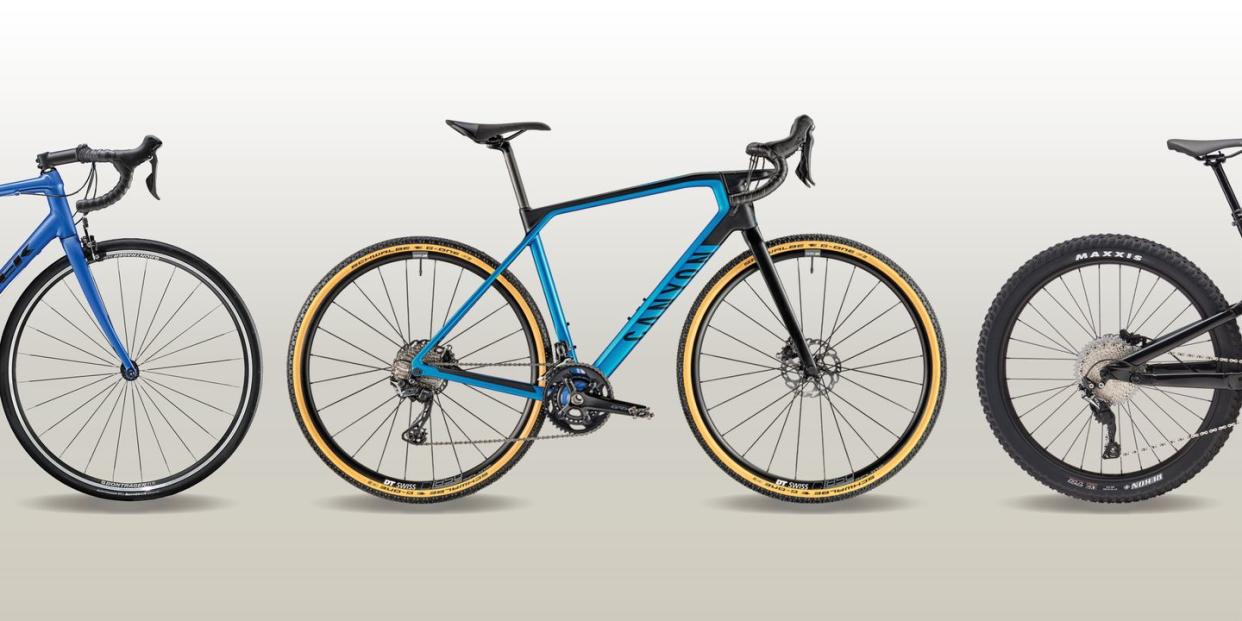
"Hearst Magazines and Yahoo may earn commission or revenue on some items through these links."
When it comes to buying a new bike, decision No. 1 is determining what type you want. The choice can seem daunting given the number of options, but it’s an important one. Bringing a road bike to the trail would be like wearing dress shoes in your workshop: laughable and potentially dangerous. The good news? Our test editors ride a lot of bikes of all different styles, and this list includes some of their favorites.
Compared to the decades-old set of wheels you might have in the garage, today’s bikes are designed to roll faster and ride smoother. Some even have electric motors to help you pedal. And high performance doesn’t always come with an equally high price tag. Most of the bikes on this list are under $1,500, and a few are even less than a grand. Whether you’ve been rolling for years and need an upgrade or are joining in on cycling’s current boom, there’s a bike for you.
Read quick reviews of five popular bike styles below, then keep scrolling for buying advice and in-depth reviews of these and other top-performing picks.
Components to Consider
Whether you’re riding for fitness, fun, or utility, the bike you’re on is, first and foremost, a machine. Brands design bike parts to maximize efficiency and ride experience. A few of these components dictate a bike’s best use and overall feel more than others and are worth paying special attention to as you shop. Keep in mind you can often upgrade parts after you buy.
Frame Material
The core of a bike is its frame, which can be made from aluminum, carbon fiber composite, or steel. Aluminum proliferates in frames because it’s affordable and balances strength with weight. It’s an ideal choice for mountain and adventure bikes and commonly used in entry-level models of all styles. Carbon, largely used among road bikes, is prized for its lightness, stiffness, and tunability (i.e. how easy it is for designers to make micro adjustments to the frame design). The weight savings and detailed engineering will cost you, though. Most carbon frame bikes are more than $2,000. Steel is heavier and less common than it used to be, but its durability and smooth ride make it a favorite for all applications and especially popular in adventure bikes and fixies.
Gearing
Like a car’s transmission, a geared bike’s drivetrain is dedicated to the finding the right gear for the situation. The more gears a bike has, the better suited it is for climbing hills but the heavier it will be. Fewer gears make a bike easier to maintain, but you might find yourself struggling to get around unless you’re traveling on flat ground or have help from an electric motor.
Gear range is determined by the number of chainrings (installed by the pedal), the number of cogs in the cassette (placed on the rear hub), and the size of those parts. (In our list below, we express the range as a formula: chainrings times cogs.) Bikes can have between one to three chainrings and typically seven to 12 cogs. A model with one chainring and eight cogs is called an 8-speed. If that same bike had a second chainring, it has 16 gear settings, but in practice, some of those settings perform identically. That’s why you don’t hear people refer to 16-speed bikes. Single-speed and fixed-gear bikes have just one chainring and one cog. (The former lets you coast, while a fixie requires constant pedaling.) Some commuter bikes have internal hubs instead of cassettes, which prevents a rusty drivetrain when your bike is regularly exposed to the elements. These sealed gear systems use a belt instead of a chain. They are exceptionally quiet and require little maintenance. The trade-off is extra weight and a slightly higher cost. As for cog size, the bigger the margin between the number of teeth in the smallest and largest cogs, the easier a bike will travel over varied terrain. An 11-46t cassette is more typical of a mountain bike, while a 11-32t is at home on a commuter or road bike.

Brakes
Disc brakes sit at the hub of each wheel. Hydraulic disc brakes use fluid to slow your wheels and deliver powerful, consistent stopping performance. That’s helpful in slick conditions, like wet pavement. But the complexity of hydraulic systems drives up the cost and requires a trained bike mechanic for upkeep. Mechanical disc brakes function similarly, but are actuated by a cable rather than hydraulic fluid. This makes the level pull more difficult, but the tradeoff is a lower price and easier maintenance. And old-school rim brakes use calipers to squeeze the wheel at the rim. They are easier to maintain and reasonably priced, but don’t provide as much stopping power and can feel a bit gummy. Lastly, there are coaster brakes, which bring you to a halt when you reverse your pedal stroke. You might remember these from your childhood bike. Today, you’ll only encounter them on beach cruisers.
Tires
Most bikes have clincher tires with inflatable inner tubes that can be prone to flats. To combat that, Mavic developed the first tubeless tire more than two decades ago, and the technology has since proliferated. These tires stay inflated with the help of a layer in the tire casing or a liquid sealant that’s added to make the rubber impermeable to air flow. Versions that need only sealant are called tubeless-ready. (That’s not to be confused with tubeless ready rims, which indicates a wheel is able to run on a tubeless system.)
As for sizing, tires are classified by two measurements—diameter and thickness—that are expressed in inches or millimeters. Most tires have a diameter of 700 mm or 27.5 in., but thickness is less prescribed. A wider tire provides more traction and a smoother ride but adds weight. That’s worth it when you’re crushing gravel, bombing down trails, or fat biking in the winter, but less so if you’re on paved surfaces.
Bike Fit and Availability
For the most comfortable and efficient riding, you need a bike that fits. You can use your height to get a rough idea, but companies have their own (often bike-specific) size guides, which you should always reference before purchasing. To cater to smaller frames, companies sometimes make women’s-specific models or sizes that have more compact frames with shortened, sloping top tubes. Plenty of unisex frames fit female bodies just fine, but if you feel stretched out, a bike with women’s-specific geometry is worth testing out.
Ride Essentials
If you’ve looked for a bike in the past few months, you’ve probably noticed a lot of models are out of stock. Bike sales boomed this spring at the onset of many states’ shelter-in-place orders. For some, bikes have become the safest mode of transportation. Others have discovered a new hobby, a sanity-saving outdoor escape method, or simply something to do when your Netflix queue is getting thin. Inventory remains low, so don’t be surprised if you see an out-of-stock or pre-order notice. You might have to wait a few weeks or months, visit your local bike shop, or search other online retailers before you bring your new bike home, but your patience and perseverance will eventually pay off. We promise to help you out by keeping an eye on inventory and updating links as often as we can.
How We Tested
Our test editors ride 365 days a year, evaluating hundreds of bikes in the process. We hammer them on our mountain bike test loop, power up our steepest road and gravel climbs, bomb our favorite Strava segments, and use them just the way you would—racing (in the pre-COVID-19 era), on weeknight rides, and running to the grocery store to pick up lunch. We also make it a habit to weigh our test bikes, though we’ve missed a few on this list and reverted to figures provided by the manufacturers. For each bike, we evaluate performance, price, comfort, handling, quality, aesthetics, and level of fun relative to similar styles. These 11 impressed enough to wind up on this list and promise excellent performance wherever you ride.
—For The Road Rider—
Motobecane Immortal Spirit
Frame Material: Carbon | Gearing: 2 x 11-speed | Brakes: Tektro R540 rim | Tires: Continental Ultra Sport II 700 x 25c | Tested Weight: 20.8 lb. (47cm)
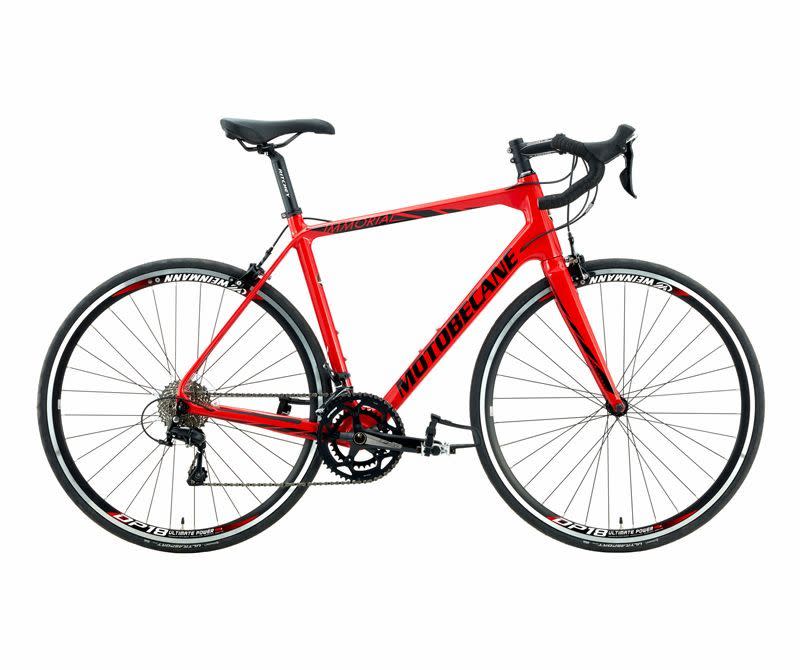
Immortal Spirit
$1199.95
bikesdirect.com
Motobecane is a direct-to-consumer brand known for bikes that score high in the value department, and the Immortal Spirit is no exception. The carbon frame and fork keep weight low, and the vibration-damping qualities of carbon make it comfortable for long rides as well as stiff and responsive to input from the pedals. Factor in the price, and this bike is great for active riders and beginner racers alike. Some may be put off by the rim brakes, but that’s a trade-off for the sake of the carbon frame and 11-speed cassette—high-end features not typically found on a bike of this price. Saddles are often the overlooked component, but our tester was impressed with the Velo on the Immortal Spirit. She remarked that it was comfortable not only while wearing padded cycling shorts but also when riding without.—Bobby Lea, test editor
—For The Gravel Crusher—
Canyon Grail CF SL 7.0
Frame Material: Carbon | Gearing: 2 x 11-speed | Brakes: Shimano SLX RT70 disc | Tires: Schwalbe G-One Bite 40mm tubeless | Tested Weight: 18.4 lb. (W XS)

Grail CF SL 7.0
$2499.00
canyon.com
For anyone who’s ever ridden for hours on gravel roads, you’ve undoubtedly reached that familiar point where your triceps ache, your shoulders start to feel a little battered, and your hands turn tingly or numb. The Canyon’s innovative double drop bar on the Grail postponed these all-day-shredding symptoms. The flexing top section cushioned our upper body when the ground was rough, and the stiffer drops lent control and confidence on fast, technical descents. Available in a women’s-specific version, the carbon adventure bike was also sprightly and responsive on sprints, and the Schwalbe tires have a low enough rolling resistance that they didn’t hold us back on the road. (For more stability, swap in 42mm tires.) If you want to feel fast and in control on road, gravel, and tame singletrack, as well as manage your comfort on bumpy terrain, this is the bike for you.—Riley Missel, test editor
For even more options check out our reviews for the best gravel bikes.
—For The Speed Demon—
Aventon Pace 500
Frame Material: Aluminum | Gearing: 1 x 8-speed | Brakes: Tektro HD-T285 hydraulic disc | Tires: Kenda Kwick Seven Sport 27.5 x 2.2” | Tested Weight: 48.9 lb. (M)
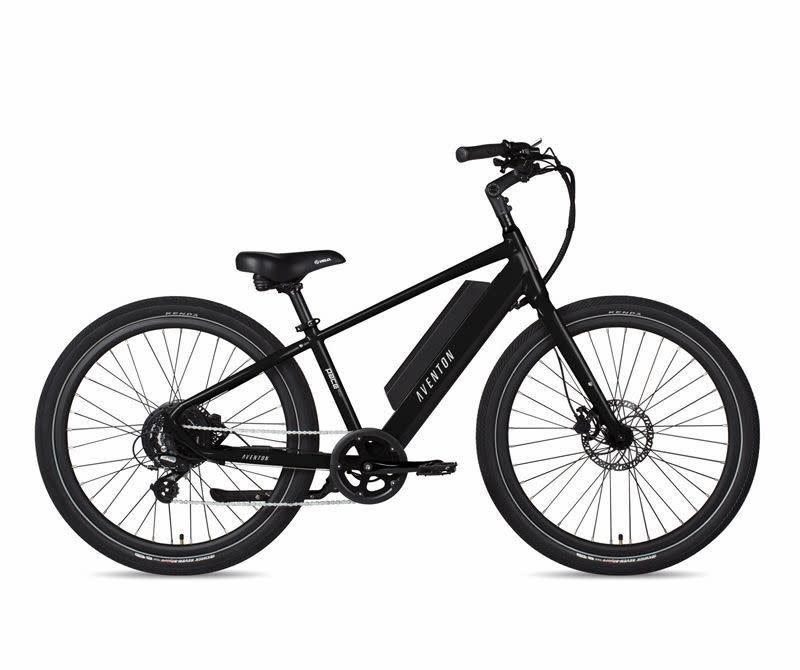
Pace 500
$1699.00
aventon.com
For a truly zippy ride, turn to the Pace 500. As soon as we turned the cranks, the Pace 500 jumped off the line like an antsy toddler at an Easter egg hunt. The urban electric bike has five levels of pedal assist topping out at 28 mph. That puts it solidly in the fastest e-bike category, Class 3. The 500 also packs a thumb-operated throttle that held steady (and by steady we mean fluctuated) between 19.7 and 20.2 mph. When we tapped the brakes, it cut out like a car’s cruise control. Having that throttle was nice on low-traffic country roads, but it’s less useful on city streets where braking is constant. The powerhouse is a 750-watt rear-hub motor and a semi-integrated battery—with a range of about 40 miles—on the down tube. The backlit display unit mounted on the stem showed a dizzying amount of information, most importantly how much juice we had left, but was easy to read. Also available with a step-through frame, the bike itself has a swept-back handlebar, ergonomic grips, a saddle the size of Texas, a sturdy kickstand, and fast-rolling e-bike–rated tires that only struggled on crunchy leaves over frozen mud. It doesn’t come equipped with fenders or a rear rack, but you can add them. But one of the most impressive features is the price. At $1,400, it’s proof that good e-bikes are no longer piling up on unattainable wish lists; they’re finally becoming a reality for the masses.—Jennifer Sherry, associate test director
—For the Commuter—
Spot Acme
Frame Material: Aluminum | Gearing: 1 x 11-speed | Brakes: HD-M275 hydraulic disc | Tires: Small Block Eight 700 x 32c | Tested Weight: 26.5 lb. (55cm)

Acme
$2199.00
spotbikes.com
The Acme is fast like a road bike, sturdy like a mountain bike, and smooth like a Cadillac. It’s as capable for slow, solo cruises as it is for fast, fitness days. The flat bar and endurance-like geometry put us in a more aggressive position than an upright city bike, but we never felt the Acme needed to go fast. From top to bottom, front to back, every part on this modest commuter bike is handpicked for quality: Alex rims, Cane Creek headset, Gates CenterTrack belt drive, Kenda tires, Shimano shifters, SRAM brakes, Spot-brand leather saddle and grips. Another cool feature? The Acme comes equipped with a Shimano Dynamo front hub that automatically charges lights (lights that you buy separately) connected via internal cable routing through the carbon fork. All these components make it a larger investment than some city bikes, but the return is in the durability. It’s a solid, unassuming bike that doesn’t compromise quality and comfort by skimping on, well, anything.—Jennifer Sherry, associate test director
—For the Fixie Fanatic—
Retrospec Harper
Frame Material: Steel | Gearing: Single-speed | Brakes: Promax rim | Tires: Kenda City Tires 700 x 28c | Claimed Weight: 25 lb.
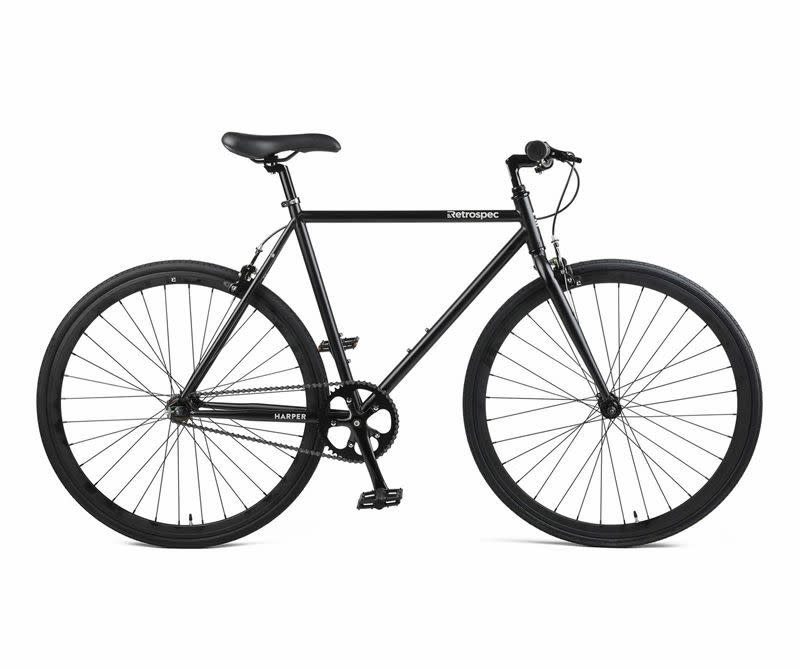
Harper
$199.99
retrospec.com
You won’t find a cheaper starter fixie than this, yet the Harper still ticks all the crucial fixed-gear boxes. The bike comes with brakes and a flip-flop hub for fixed-gear or single-speed riding. With an upright riding position, thick tires, and a sturdy steel frame, it’s an ideal ride for commuting and cruising. Plus, Retrospec offers the bikes in five sizes and six colors, so you can personalize it.—Dan Roe, test manager
—For the Coastal Cyclist—
Priority Coast 3-Speed
Frame Material: Aluminum | Gearing: 1 x 3-speed | Brakes: Rim and coaster | Tires: Kendra Puncture Resistant 26 x 2.1" | Tested Weight: 30.3 lb.
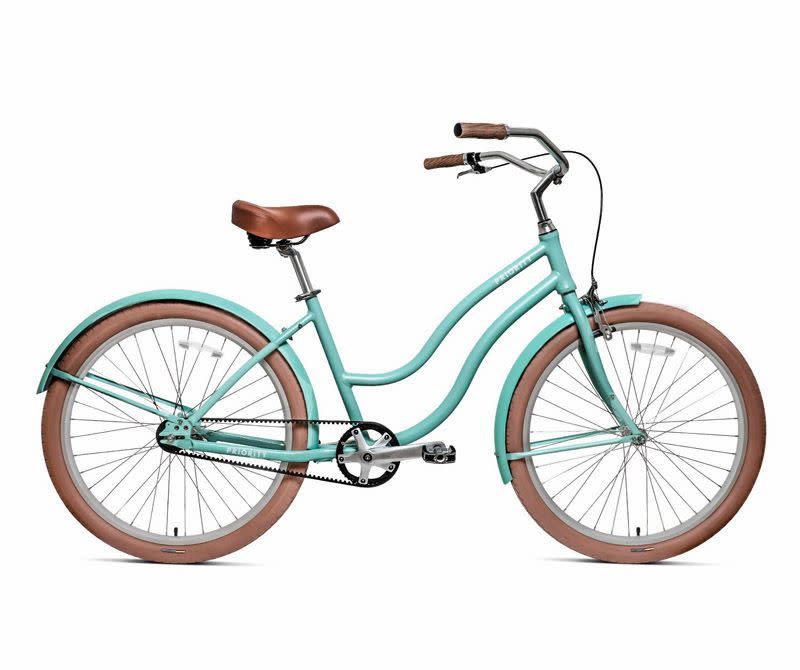
Coast
$599.00
prioritybicycles.com
The salt air is no match for the Coast’s rustproof components, which include stainless-steel spokes, an aluminum frame and fork, and a maintenance-free Gates Carbon Drive belt (that accompanies the non-weatherproof Shimano Nexus 3-speed internal hub). Sealed bearings keep out water, and Kenda puncture-resistant tires are hardly fazed by broken glass and clamshells. On boardwalks and level city roads, we rolled at a faster pace in the hardest gear, and on slight inclines, we took advantage of the slightly easier pedaling. Still, this bike isn’t in a hurry. We often found ourselves barely hanging on to the cruiser-style handlebar—using just the fingers on one hand to guide the bike along and even turn corners. And the super-wide saddle (10 inches at its widest part) is so comfortable, it’s like surfing your favorite recliner, as long as you keep rides relatively short. Although there’s a front hand brake on the left side, laziness made us coaster-brake converts. The Coast is available with a step-through or traditional frame, though the latter won’t fit shorter riders.—Jennifer Sherry, associate test director
—For The Cargo Hauler—
Rad Power Bikes RadWagon 4
Frame Material: Aluminum | Gearing: 1 x 7-speed | Brakes: Tektro Aries MD-M300 mechanical disc | Tires: Rad Power Bikes 22 x 3” | Claimed Weight: 73 lb.
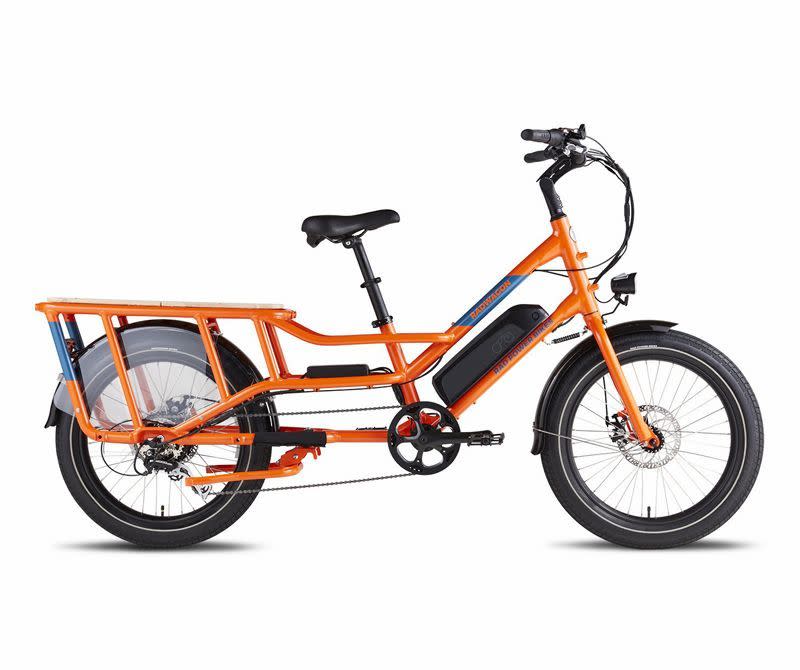
RadWagon 4
$1999.00
radpowerbikes.com
A $1,500 fully loaded e-cargo bike seemed too good to be true, but the RadWagon stands up to competitors that cost thousands more. A 750-watt Shengyi direct-drive hub motor provides powerful pedal assist at a much quieter hum than the mid-drive motors used on most e-cargo bikes; its only disadvantage is there’s not quite as much torque, but we only noticed on steep hills. A throttle lets us ride the bike like a scooter, and we averaged 35 miles per charge from the 48-volt battery (you’ll likely get more than 40 on mostly flat routes). The RadWagon is 79 inches long and weighs as much as a 10-year-old, but despite being an absolute beefcake, it handles surprisingly well. We thrashed it around an abandoned golf cart path and didn’t scrape the rear foot platforms against the ground, a good sign for low-speed handling. The integrated front and rear lights, fenders, and a kickstand are standard, and we had no problems with the 7-speed Shimano Altus drivetrain or the Tektro mechanical disc brakes. It’s a lot easier to charge $5,000 or more for an e-cargo bike when you market it as a car replacement, but the RadWagon proves you can render your car mostly obsolete for the price of an e-bike, not another car.—Dan Roe, test manager
—For The Beginning Racer—
Trek Domane AL 2
Frame Material: Aluminum | Gearing: 2 x 8-speed | Brakes: Dual-pivot rim | Tires: Bontrager R1 Hard-Case Lite 700 x 28c | Claimed Weight: 22.1 lb.
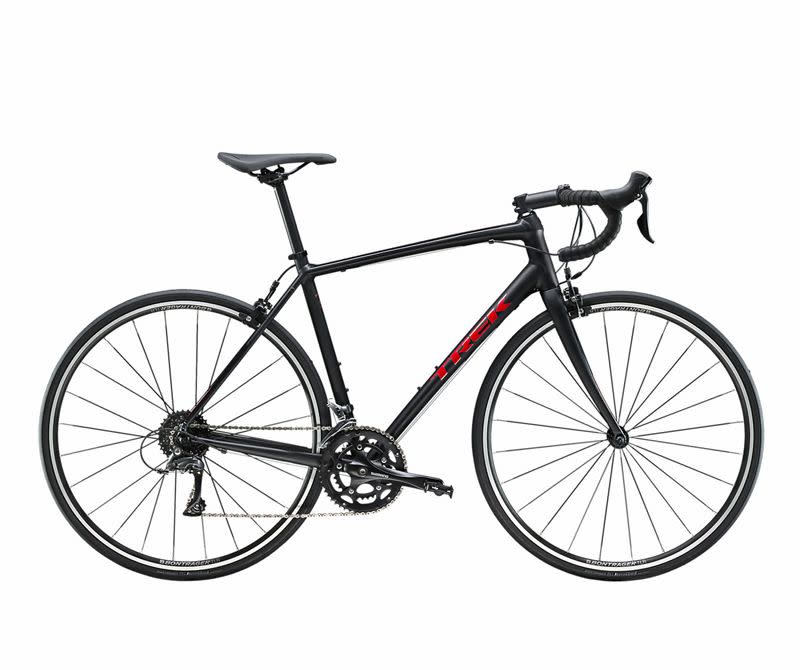
Trek
Domane AL 2
$859.99
Shop Now
The good looks of the Domane AL 2 are the first indication that Trek didn’t mess around with this $860 bike. Start digging deeper and you’ll find even more to like. The shaped aluminum frame is nicely made and has a vibration-damping carbon fork. The rims are tubeless-ready so you can upgrade to smoother-rolling tires filled with puncture sealant, and they’re machined for smoother braking. Speaking of the brakes, they have a light pull and a firm bite on the rim—no vague mushiness here—and provide the best slowing and stopping performance we’ve ever sampled on a sub-$1,000 bike. The shifters snick-snick the drivetrain through the gears lightly and crisply. There are other little surprising nuggets, like the pocket in the frame for a speed sensor and the included light and computer mount that cleanly integrates into the stem. Best of all, the bike is a joy to ride. Handling is stable, precise, and attentive to pedal strokes so you feel like you’re flying over the road, not pushing across it.—Bobby Lea, test editor
—For the Go-Anywhere Rider—
Specialized Sirrus X 4.0
Frame Material: Aluminum | Gearing: 1 x 10-speed | Brakes: Shimano BR-MT200 hydraulic disc | Tires: Pathfinder Sport 700 x 38mm | Tested Weight: 23.3 lb. (S)
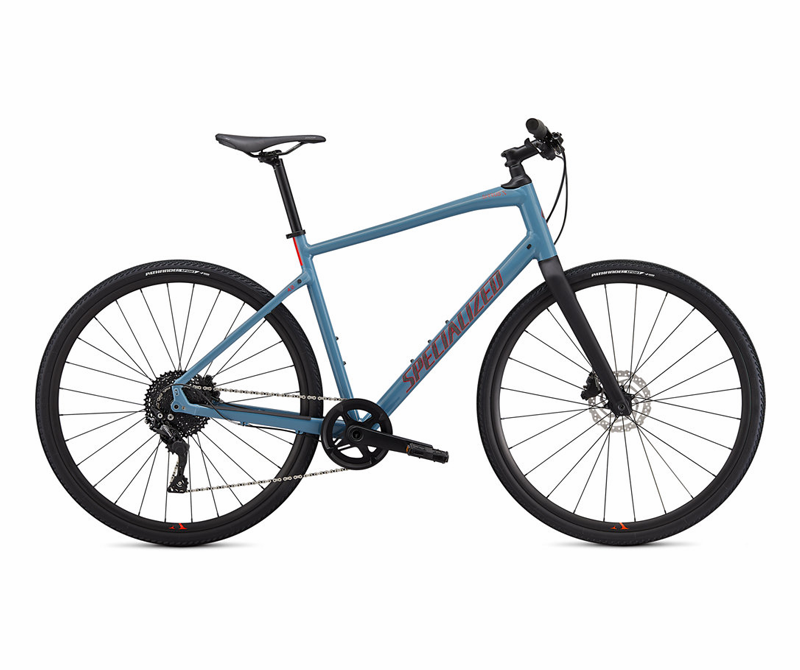
Sirrus X 4.0
$1350.00
specialized.com
If you’re searching for a hybrid bike that is as fun to ride as it is utilitarian, consider the Specialized Sirrus X 4.0. The 38mm-wide Pathfinder Sport tires have knobby sides for cornering and a flat strip down the middle for rolling fast on pavement. The carbon fork, wide tires, and handlebar suspension smooth out the ride. A wide gear range plus rack and fender mounts mean you can haul your stuff even where it’s hilly. It’s fast and maneuverable, making it ideal for quick city commutes and efficient errand running. To expand its capabilities, Specialized added 38mm gravel tires and its Future Shock, a rubber-encased coil shock above the headset with 20mm of travel to help absorb any front-tire impacts. These additions, plus the carbon fork, contribute to smoothing out your ride on any road.—Riley Missel, test editor
—For the Trail Ripper—
Cannondale Bad Habit 2
Frame Material: Aluminum | Gearing: 1 x 11-speed | Brakes: Shimano MT400 hydraulic disc | Tires: Maxxis Rekon 27.5 x 2.8” tubeless ready | Tested Weight: 33.3 lb. (XL)
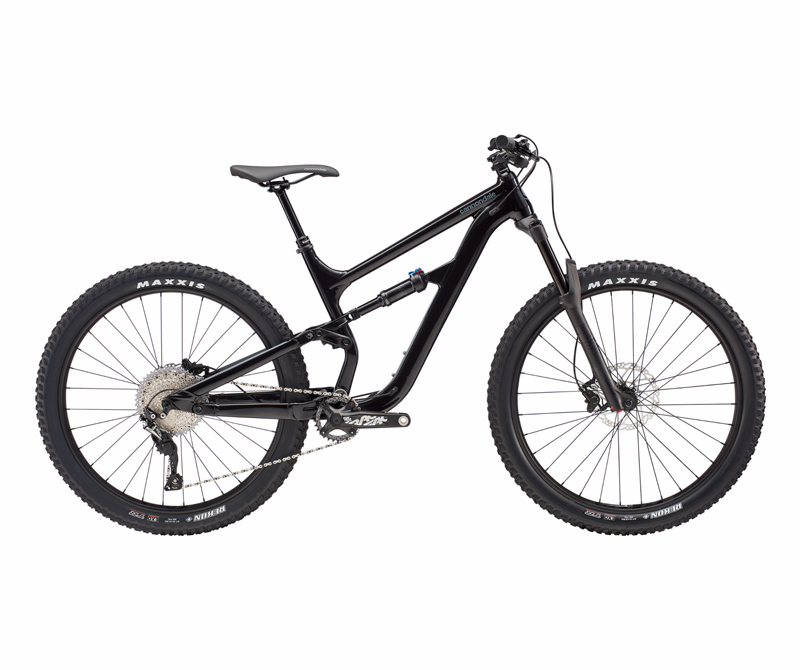
Cannondale
Bad Habit 2
$2,625.00
Shop Now
The Bad Habit is the plus-tire version of Cannondale's best-ever suspension bike, the Habit. Instead of the Habit’s 29er wheels, the Bad Habit gets 27.5 wheels wrapped with 2.8-inch-wide tires for more traction, better flotation, and a more sure-footed and stable feel. The Bad Habit’s geometry is modern, though not as crazy long as some of its competitors, which helps it handle better in slower terrain. And it climbs far better than you think a 33-pound trail bike should, which is critical if you aren’t a lift service kind of rider. The 140mm RockShox Sektor RL fork features a compression adjustment knob that’s easy to reach while riding. Rather than a full lockout, you can micro-adjust compression on the fly then push it all the way to WFO when you’re ready to rip down the mountain. The low bottom bracket makes it challenging to get over technical features like logs and big rocks while climbing, but once you get used to the minimal pedal clearance it becomes easier to manage. The rear suspension offers well-rounded performance, and with an aluminum frame and great parts of the money, this is a plus bike well worth the money.—Bobby Lea, test editor
—For the Adrenaline Junkie—
Salsa Timberjack NX Eagle 29
Frame Material: Aluminum | Gearing: 1 x 12-speed | Brakes: SRAM Level hydraulic disc | Tires: WTB Trail Boss 29x2.6" | Tested Weight: 30.8 lb. (L)
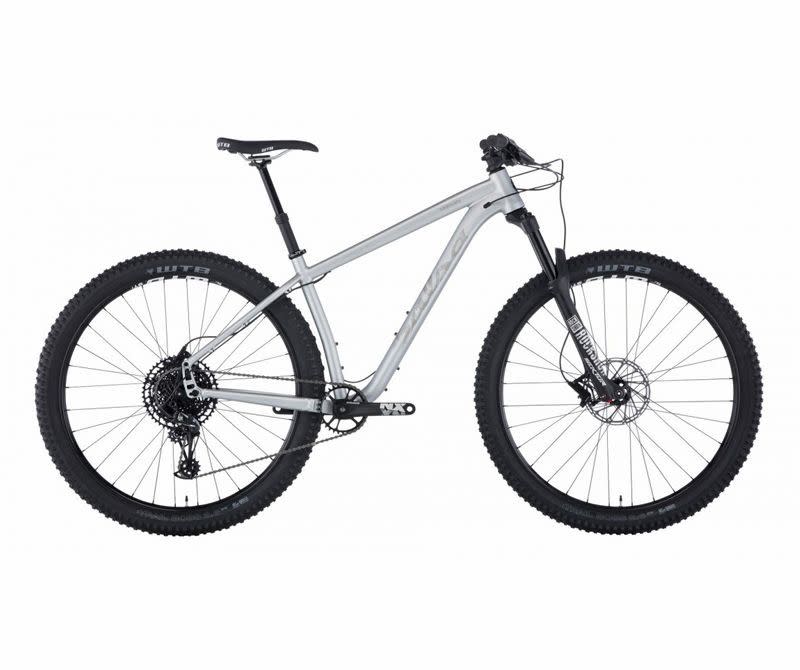
Timberjack NX Eagle 29
$1999.00
salsacycles.com
The Timberjack is a fun, adventure-ready aluminum hardtail that’ll run 29-inch or plus-sized 27.5-inch wheels. Short chainstays keep it nimble in tight situations, while a longer top tube provides stability. The bike felt a bit long over slow-speed, technical sections, but the long and slack layout yielded fast descents. We were surprised by how competent it was slamming into big rock gardens at speeds we would’ve reserved for full-suspension bikes; we didn’t feel that our trail choice was restricted by the lack of rear suspension whatsoever. For the NX build, Salsa gives you a RockShox Sektor RL fork with 130mm of travel—enough for most trail rides. SRAM’s NX drivetrain components provide crisp shifting, and the bike comes with tubeless-ready wheels. The Timberjack has internal cable routing and mounts for a rear rack for light bikepacking or whatever adventures you plan. Salsa’s Alternator dropouts make it possible to run the Timberjack as a single-speed, too.—Dan Roe, test manager
You Might Also Like

